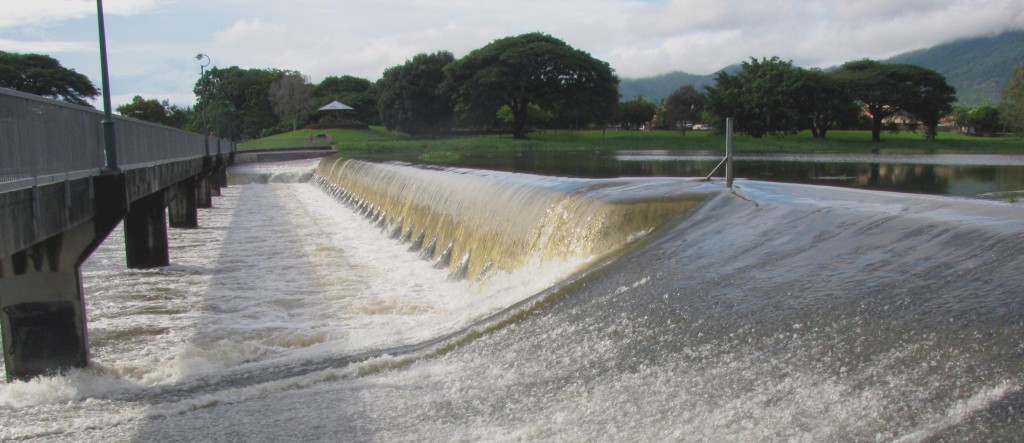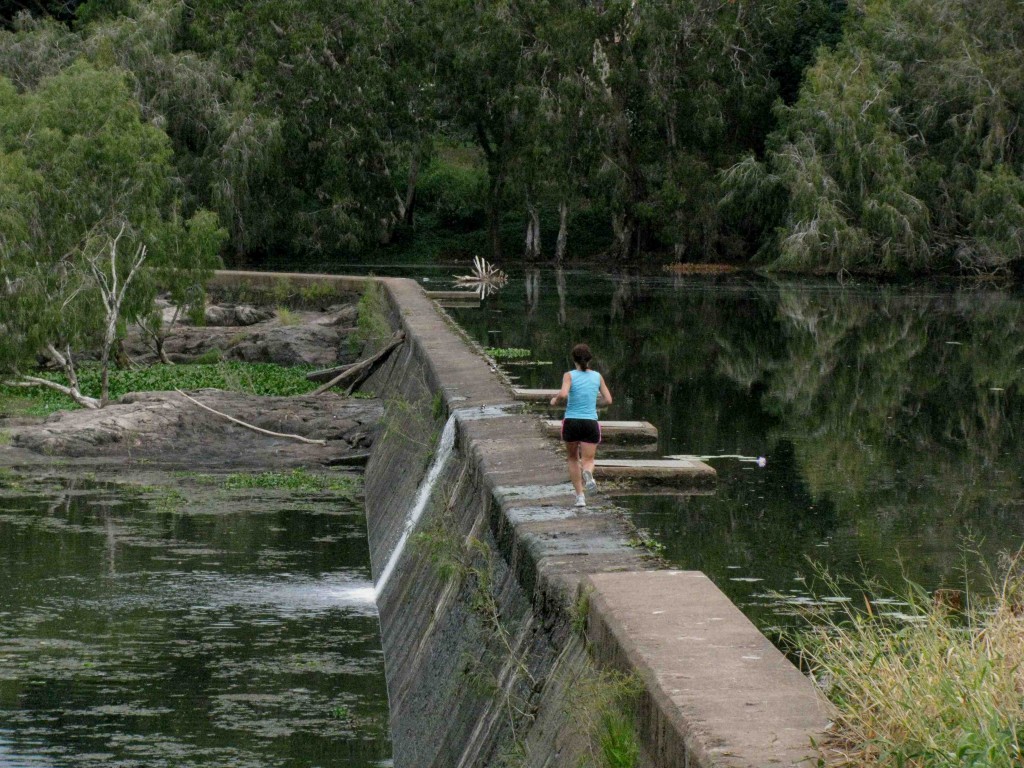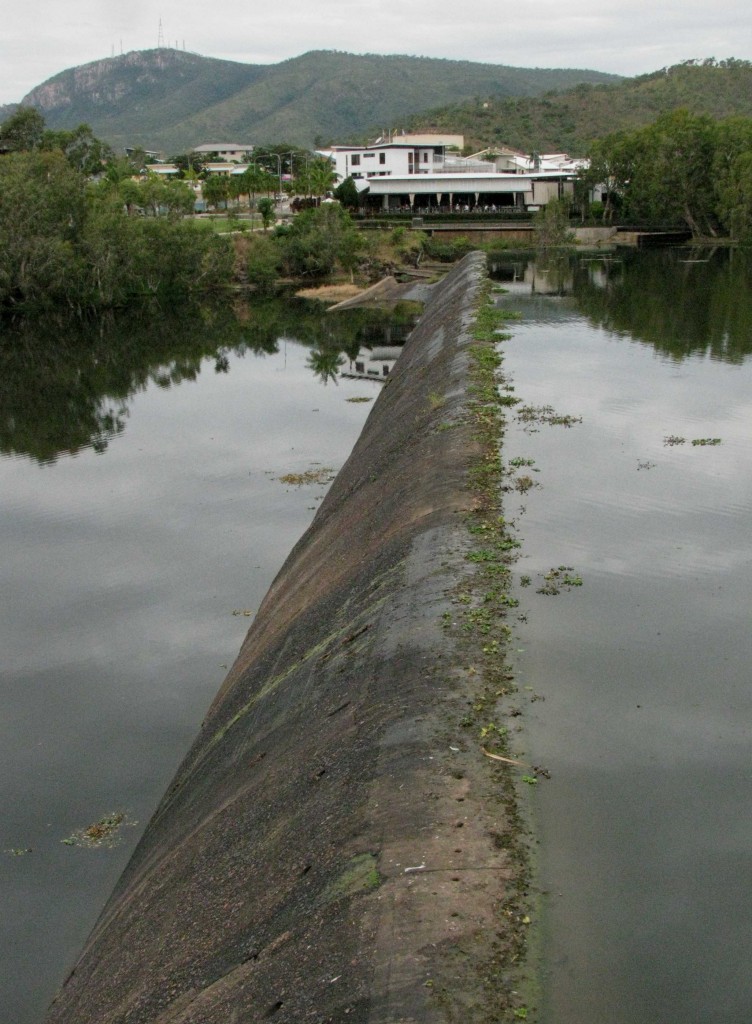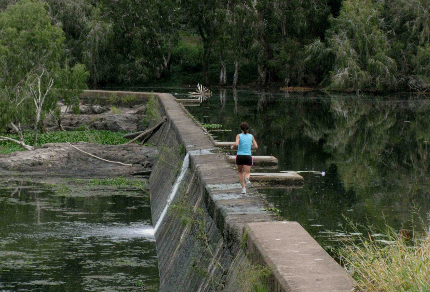
Aplin’s Weir, February 28, 2010 (© Vilis Nams)
In late afternoon, the Ross River ran blue and full, its surface flecked with small waves whipped up by wind, the incoming tide pushing a blend of salt and fresh water upstream through Bicentennial Park and over the tidal lagoons of thick grasses alongside the Ross River Parkway as far as Aplin’s Weir. That weir was constructed as a stop weir to block the infiltration of salt water into wells located downstream from Townsville’s first weir, Gleeson’s Weir, which supplied water to Townsville’s early residents.1

Aplin’s Weir, May 21, 2010 (© Magi Nams)
In 1864, Townsville was created as a new port city for North Queensland. Eighteen years later, the Townsville Water Authority was established to oversee the delivery of water to the city’s residents.1 In a dry tropics climate where the 2-3 month Wet alternates with a long dry season, the supply of water was one of crucial importance to the developing city, and still is. At the close of this year’s Wet, Level 1 water restrictions were implemented in Townsville, restricting the watering of lawns and gardens to between 4 p.m. and 9 a.m. on alternating days.
Yesterday, when I cycled to Pioneer Park, I passed all three weirs on the Ross River – first Aplin’s Weir, the closest to home, then Gleeson’s Weir, and finally Black Weir, named after John Melton Black, one of the founders of Townsville.
Originally built in 1927, the first edition of Aplin’s Weir was a barricade of steel sheeting topped by a concrete overflow.1 That was replaced in 1944 by the solid concrete barrier1 so familiar to me after numerous cycling excursions across the adjacent pedestrian bridge. Water thundered over Aplin’s Weir during the Wet, but has since decreased in volume until only a trickle flows over it now. Downstream from the weir, fishos cast for barra, and egrets, ibises, spoonbills, storks, cormorants, and pelicans hunt frogs and fish in the river and its tidal lagoons.

Gleeson’s Weir, May 21, 2010 (© Magi Nams)
Gleeson’s Weir, constructed in 19081 and barricading the river about 4 kilometres upstream from Aplin’s Weir, is the oldest of the Ross River’s three weirs. Its 210-metre length, shaped as a lopsided V, is slated for reinforcement this year, when the overall thickness of the barricade will be doubled.2 The aquatic environment between Aplin’s and Gleeson’s Weirs shows none of the surging flood and ebb of the tidal river below Aplin’s Weir. It features water lilies, lotus lilies, and water hyacinths growing at the river’s edges, with comb-crested jacanas employing their extremely long toes to walk on the floating vegetation. Rowers and canoeists ply the river between the two weirs, and swimmers jump in from ropes or swimming pontoons, not having the concern of saltwater crocodiles, which occur in the estuarine blend of salt and fresh water below Aplin’s Weir.

Black Weir, May 21, 2010 (© Magi Nams)
Black Weir, the third of the river’s weirs and the longest, was constructed about a kilometre upstream from Gleeson’s Weir in 1934 after still more water was needed to supply the city’s demands.1 The catchment behind the weir filled in 1936, providing a good water supply until World War II broke out and large platoons of American and Australian soldiers were stationed in Townsville, again increasing the water demand.1
From an interpretive sign at Black Weir, I learned that, during the 1950’s, extra water was piped to Townsville from Crystal Creek in the Paluma Range through the Mount Spec pipeline – that long, white pipeline that mystified Vilis and me when we first drove to Paluma in early January. The Ross River Dam was completed in 1972 and now supplies most of the city’s water. Still, the weirs act as back-up and, as we’ve observed, play a supporting role in leashing the river’s power during the wet.
References:
1.Townsville Town Council. Citylibraries Heritage Services Information Sheet. Ross River Weirs. Accessed 24-May-2010. http://www.townsville.qld.gov.au/resources/1307.pdf
2. Townsville City Council. Media Release, April 29, 2010. Century old Gleeson’s Weir to undergo stability works. Updated 10-Mar-2008. Accessed 24-May-2010. http://www.townsville.qld.gov.au/council/media?media_id=616


